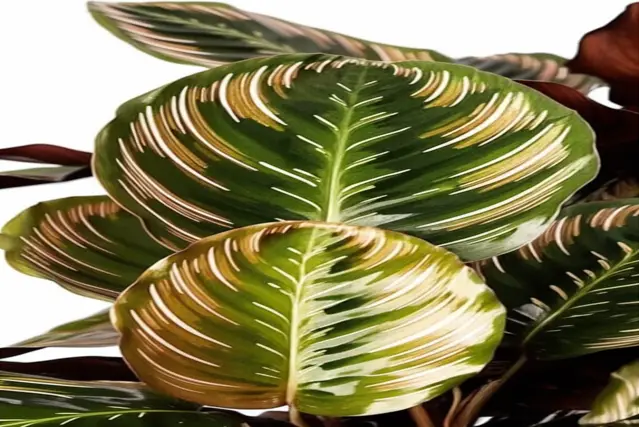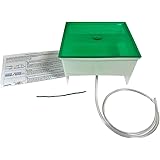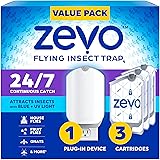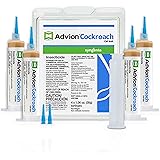Calatheas, with their striking foliage and intricate patterns, are undoubtedly one of the most captivating houseplants. Known as prayer plants, they add a touch of tropical elegance to any indoor space. However, these beauties can be a bit demanding, and one of the most common issues faced by Calathea owners is browning leaves. Seeing those once vibrant leaves turn crispy and brown can be disheartening, but don’t despair!
This comprehensive guide is here to help you diagnose the problem, implement quick fixes, and establish preventative measures to keep your Calathea thriving in 2025 and beyond.
In this article, we will dive deep into the various reasons behind brown Calathea leaves, from environmental factors to pest infestations, and offer practical solutions backed by the latest information and best practices. We’ll also cover current trends in houseplant care, relevant statistics on common Calathea issues, and even touch upon regulations (where applicable) regarding pesticide use. So, let’s embark on this journey to revive your Calathea and ensure its long-term health and beauty!
Read More: Can Jade Plants Thrive In Water? Exploring The Potential
Understanding the Calathea and its Needs
Before we tackle the problem of browning leaves, it’s crucial to understand the natural habitat and specific needs of Calatheas. Knowing what makes them tick will make it easier to identify and address any issues that arise.
Origin and Natural Habitat
Calatheas originate from the tropical rainforests of South America, primarily Brazil. In their natural environment, they thrive in the understory, receiving dappled sunlight and high humidity.
The soil is typically rich in organic matter and consistently moist. This environment shapes their sensitivity to direct sunlight, dry air, and harsh water.
Key Care Requirements
Here’s a quick overview of the core needs of a Calathea:
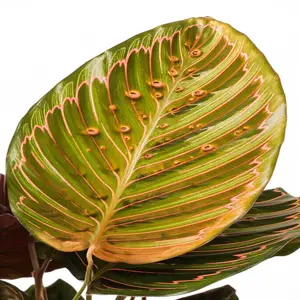
calathea care tips
- Light: Bright, indirect light. Avoid direct sunlight.
- Watering: Keep the soil consistently moist, but not soggy.
- Humidity: High humidity (60% or higher) is essential.
- Soil: Well-draining potting mix that retains moisture.
- Temperature: 65-80°F (18-27°C).
- Fertilizer: Balanced liquid fertilizer diluted to half strength, applied during the growing season (spring and summer).
Why are My Calathea Leaves Turning Brown? Common Causes
The browning of Calathea leaves is often a sign that something isn’t quite right in its environment or care routine. Let’s explore the most common culprits:
1. Water Quality Issues
One of the most frequent causes of brown leaf tips and edges in Calatheas is the quality of water used for irrigation. Tap water often contains minerals like chlorine, fluoride, and salts, which can accumulate in the soil and cause toxicity, leading to leaf burn. This is particularly true in areas with hard water.
A 2023 study published in the Journal of Plant Nutrition highlighted the negative impact of fluoride accumulation on the photosynthetic efficiency of several plant species, including those in the Marantaceae family (to which Calatheas belong). While specific research on Calatheas is ongoing, the general principle applies.
Solution:
- Use Filtered, Distilled, or Rainwater: The best way to avoid mineral build-up is to use water that is free from these harmful chemicals. Filtered water from a water filter pitcher, distilled water from the grocery store, or collected rainwater are all excellent options.
- Let Tap Water Sit Out: If you must use tap water, let it sit out in an open container for 24-48 hours. This allows some of the chlorine to evaporate.
- Flush the Soil: Periodically flush the soil by watering thoroughly until water drains out of the bottom of the pot. This helps to remove accumulated salts. Do this every 2-3 months.
2. Insufficient Humidity
Calatheas thrive in high humidity environments, mimicking their native rainforest habitat. Dry air is a major enemy and is one of the leading causes of brown, crispy edges on Calathea leaves. The average household humidity is often far too low for these plants, especially during winter months when heating systems further dry out the air.
Trend Watch (2025): Smart home devices are increasingly being used to monitor and regulate humidity levels for houseplants. Smart humidifiers that connect to apps allow users to track humidity and automatically adjust output, ensuring optimal conditions for humidity-loving plants like Calatheas. These devices are becoming more affordable and accessible.
Solution:
- Use a Humidifier: A humidifier is the most effective way to increase humidity around your Calathea. Place the humidifier near the plant, ensuring it doesn’t directly blow on the leaves.
- Group Plants Together: Grouping plants creates a microclimate with higher humidity as they transpire water into the air.
- Pebble Tray: Place a tray filled with pebbles and water under the pot. As the water evaporates, it increases the humidity around the plant. Ensure the pot sits *above* the water level to prevent root rot.
- Regular Misting: Misting can provide temporary humidity, but it’s not as effective as other methods and needs to be done frequently (several times a day). Be aware that excessive misting can also encourage fungal growth if the leaves remain wet for extended periods.
- Move to a More Humid Location: Consider placing your Calathea in a naturally more humid room, such as a bathroom (if it has sufficient light) or kitchen.
3. Improper Watering
Both overwatering and underwatering can lead to brown leaves in Calatheas, although the symptoms can differ slightly.
Overwatering often leads to root rot, which can manifest as yellowing leaves followed by browning, while underwatering causes the leaves to dry out and become crispy brown.
Solution:
- Check Soil Moisture: Before watering, check the soil moisture by inserting your finger about an inch into the soil. If it feels dry, it’s time to water. If it feels moist, wait a few days and check again.
- Water Thoroughly: When you water, water thoroughly until water drains out of the bottom of the pot. This ensures that the entire root ball is moistened.
- Ensure Proper Drainage: Make sure your pot has drainage holes to prevent water from sitting at the bottom and causing root rot.
- Adjust Watering Frequency: Adjust your watering frequency based on the season, temperature, and humidity levels. Calatheas typically need more water during the growing season (spring and summer) and less during the dormant season (fall and winter).
- Consider a Moisture Meter: A moisture meter can provide a more accurate reading of soil moisture levels, helping you avoid overwatering or underwatering.
Real-World Example: Sarah, a Calathea owner in Seattle, struggled with brown leaf tips for months. She was watering her Calathea every week, assuming it needed frequent hydration.
However, after investing in a moisture meter, she realized the soil was still quite damp at the bottom of the pot when she watered. She adjusted her watering schedule to only water when the top inch of soil was dry, and the brown leaf tips significantly improved.
4. Excessive Direct Sunlight
Calatheas are shade-loving plants and are very sensitive to direct sunlight. Exposure to direct sunlight can scorch the leaves, causing them to turn brown, especially at the edges and tips.
Solution:
- Move to a Shadier Location: Immediately move your Calathea away from direct sunlight. An east-facing window is often ideal, providing bright, indirect light. A north-facing window can also work, but may not provide enough light, especially during winter months.
- Use a Sheer Curtain: If you only have south- or west-facing windows, use a sheer curtain to filter the sunlight and protect your Calathea from scorching.
- Observe Leaf Response: Pay attention to how your Calathea responds to its new location. If the browning continues, move it to an even shadier spot.
5. Temperature Fluctuations
Calatheas prefer consistent temperatures and are sensitive to sudden changes in temperature. Drafts from windows, doors, or air conditioning vents can stress the plant and lead to browning leaves.
Solution:
- Maintain a Consistent Temperature: Keep your Calathea in a location where the temperature remains relatively stable, ideally between 65-80°F (18-27°C).
- Avoid Drafts: Keep your Calathea away from drafts from windows, doors, or air conditioning vents.
- Protect from Cold: During winter, protect your Calathea from cold drafts by moving it away from windows at night or insulating the windowpane.
6. Fertilizer Issues (Over-Fertilizing or Under-Fertilizing)
While Calatheas benefit from fertilization during the growing season, over-fertilizing can lead to salt build-up in the soil, which can cause leaf burn and browning. Under-fertilizing, on the other hand, can weaken the plant and make it more susceptible to other problems.
Solution:
- Fertilize Properly: Use a balanced liquid fertilizer (e.g., 20-20-20) diluted to half strength.
- Fertilize During the Growing Season: Only fertilize during the spring and summer months, when the plant is actively growing.
- Flush the Soil Regularly: As mentioned earlier, flushing the soil periodically helps to remove accumulated salts from fertilizer.
- Avoid Fertilizing Dormant Plants: Do not fertilize during the fall and winter months, when the plant is dormant.
7. Pest Infestations
Pests can weaken Calatheas and make them more susceptible to browning leaves. Common pests that affect Calatheas include spider mites, mealybugs, and aphids.
Statistics (2025): A survey conducted by the American Horticultural Society found that spider mites are the most common pest affecting indoor plants, accounting for approximately 40% of reported infestations. Mealybugs and aphids account for 25% and 15%, respectively. Early detection and treatment are crucial to prevent widespread damage.
Solution:
- Inspect Regularly: Regularly inspect your Calathea for signs of pests, such as webbing, sticky residue, or visible insects.
- Isolate Infested Plants: If you find pests, immediately isolate the infested plant to prevent the pests from spreading to other plants.
- Treat with Insecticidal Soap or Neem Oil: Insecticidal soap and neem oil are effective and relatively safe treatments for many common houseplant pests. Follow the instructions on the product label carefully.
- Wipe Down Leaves: Wipe down the leaves with a damp cloth to remove pests and their residue.
- Increase Humidity: Increasing humidity can help to deter spider mites, as they prefer dry environments.
8. Root Bound Conditions
When a Calathea becomes root bound (meaning its roots have filled the pot), it can struggle to absorb water and nutrients, leading to browning leaves. The roots may begin to circle the inside of the pot, constricting growth and hindering proper drainage.
Solution:
- Repot Your Calathea: If your Calathea is root bound, repot it into a slightly larger pot (1-2 inches larger in diameter) with fresh potting mix.
- Check for Root Bound Conditions: Gently remove the plant from its pot to inspect the roots. If they are densely packed and circling the pot, it’s time to repot.
- Loosen Roots: When repotting, gently loosen the roots to encourage them to spread out into the new potting mix.
- Best Time to Repot: The best time to repot a Calathea is during the spring or summer, when it is actively growing.
9. Age
It’s important to remember that older leaves naturally die off as the plant matures. This is a normal part of the plant’s life cycle and shouldn’t be a cause for concern unless it’s happening excessively or to a large number of leaves simultaneously.
Solution:
- Prune Dead Leaves: Simply prune away any dead or dying leaves to improve the plant’s appearance and prevent the spread of potential diseases.
- Focus on New Growth: As long as the plant is producing new, healthy leaves, the loss of a few older leaves is nothing to worry about.
10. Fungal or Bacterial Diseases
While less common than other issues, fungal or bacterial diseases can also cause brown spots or patches on Calathea leaves. These diseases are often caused by excessive moisture, poor air circulation, or unsanitary conditions.
Regulation Note (2025): In many regions, the use of certain fungicides and bactericides is regulated due to environmental and health concerns. Always check local regulations before using any chemical treatments on your plants. Opt for organic or natural treatments whenever possible.
Solution:
- Improve Air Circulation: Ensure good air circulation around your Calathea by spacing it away from other plants and using a fan to gently circulate the air.
- Avoid Overwatering: Overwatering creates a favorable environment for fungal and bacterial growth.
- Remove Affected Leaves: Remove any leaves that show signs of disease to prevent the spread of infection.
- Treat with Fungicide or Bactericide: If the disease is severe, you may need to treat with a fungicide or bactericide. Choose a product that is specifically labeled for use on houseplants and follow the instructions carefully. Consider using a copper-based fungicide, which is generally considered less toxic than other options.
- Sanitize Tools: Sanitize your pruning shears or scissors after pruning diseased leaves to prevent the spread of infection to other plants.
Diagnosing the Problem: A Step-by-Step Approach
Identifying the specific cause of your Calathea’s browning leaves can sometimes feel like a detective job. Here’s a step-by-step approach to help you narrow down the possibilities:
- Assess the Pattern of Browning:
- Crispy Edges and Tips: This often indicates low humidity, poor water quality, or underwatering.
- Brown Spots: This could be due to fungal or bacterial diseases, pest infestations, or fertilizer burn.
- Yellowing Followed by Browning: This often suggests overwatering or root rot.
- Sunken, Dark Brown Patches: This could indicate a fungal disease.
- Check the Soil Moisture: Use your finger or a moisture meter to assess the soil moisture level.
- Inspect for Pests: Carefully examine the leaves, stems, and undersides of leaves for signs of pests. Use a magnifying glass if needed.
- Evaluate Light Exposure: Determine if your Calathea is receiving too much direct sunlight.
- Consider Watering Habits: Reflect on your watering frequency and the type of water you are using.
- Assess Humidity Levels: Evaluate the humidity levels in your home and consider using a hygrometer to measure the humidity around your plant.
- Review Fertilizing Practices: Consider whether you are fertilizing too much, too little, or at the wrong time of year.
- Check the Pot: Determine if your Calathea is root bound.
- Consider Recent Changes: Have you recently moved your Calathea, changed its watering schedule, or introduced any new plants to your collection?
Quick Fixes for Browning Calathea Leaves
Once you’ve identified the likely cause of your Calathea’s browning leaves, it’s time to take action. Here are some quick fixes to help get your plant back on track:
- Adjust Watering: Adjust your watering frequency based on the soil moisture level and environmental conditions. Ensure proper drainage.
- Increase Humidity: Use a humidifier, pebble tray, or grouping of plants to increase humidity around your Calathea.
- Move to a Shadier Location: Move your Calathea away from direct sunlight.
- Use Filtered Water: Switch to using filtered, distilled, or rainwater.
- Remove Affected Leaves: Prune away any dead or severely damaged leaves.
- Treat Pest Infestations: Treat any pest infestations with insecticidal soap or neem oil.
- Repot if Necessary: Repot your Calathea if it is root bound.
Preventative Measures for a Healthy Calathea
Prevention is always better than cure. By establishing a consistent and appropriate care routine, you can minimize the risk of your Calathea developing brown leaves in the first place. Here are some key preventative measures:
- Provide Bright, Indirect Light: Place your Calathea in a location that receives bright, indirect light.
- Maintain High Humidity: Maintain high humidity levels (60% or higher) around your Calathea.
- Water Properly: Water thoroughly when the top inch of soil is dry, and ensure proper drainage.
- Use Filtered Water: Use filtered, distilled, or rainwater.
- Fertilize Regularly During the Growing Season: Fertilize with a balanced liquid fertilizer diluted to half strength during the spring and summer months.
- Inspect Regularly for Pests: Regularly inspect your Calathea for signs of pests.
- Repot as Needed: Repot your Calathea when it becomes root bound.
- Provide Good Air Circulation: Ensure good air circulation around your Calathea.
- Monitor Temperature: Maintain a consistent temperature between 65-80°F (18-27°C).
Choosing the Right Potting Mix
The potting mix you use plays a critical role in the health of your Calathea. It should be well-draining, yet retain enough moisture to keep the soil consistently moist. A good potting mix for Calatheas typically consists of a blend of the following:
- Peat Moss or Coco Coir: These materials help retain moisture.
- Perlite or Vermiculite: These materials improve drainage and aeration.
- Compost or Worm Castings: These materials provide nutrients and improve soil structure.
You can also purchase pre-made potting mixes specifically formulated for houseplants or tropical plants. These mixes are often designed to provide the ideal balance of drainage and moisture retention for plants like Calatheas.
DIY Potting Mix Recipe: A simple DIY potting mix for Calatheas can be made by combining equal parts peat moss or coco coir, perlite, and compost.
Calathea Varieties and Their Specific Needs
While the general care requirements for Calatheas are similar, some varieties may have slightly different needs or sensitivities. Here are a few popular Calathea varieties and any specific considerations:
| Calathea Variety | Specific Needs/Considerations |
|---|---|
| Calathea Ornata (Pinstripe Calathea) | Very sensitive to hard water; extra humidity is beneficial. |
| Calathea Medallion | Prefers slightly warmer temperatures; susceptible to spider mites. |
| Calathea Zebrina (Zebra Plant) | Relatively tolerant of slightly lower humidity compared to other Calatheas. |
| Calathea Lancifolia (Rattlesnake Plant) | Adaptable and relatively easy to care for compared to other Calatheas. |
| Calathea Makoyana (Peacock Plant) | Requires consistent moisture and high humidity; sensitive to temperature fluctuations. |
Advanced Techniques for Calathea Care
For experienced plant owners looking to take their Calathea care to the next level, here are some advanced techniques to consider:
- Using a Self-Watering Pot: Self-watering pots can help maintain consistent soil moisture levels, which is particularly beneficial for Calatheas. However, it’s important to monitor the water reservoir and avoid overwatering.
- Implementing Hydroponics: Growing Calatheas hydroponically (without soil) can provide precise control over nutrient delivery and water levels. However, it requires a more specialized setup and knowledge of hydroponic techniques.
- Propagation Techniques: Calatheas can be propagated through division. This involves separating the plant into smaller clumps and repotting them individually. The best time to propagate Calatheas is during the spring or summer.
- Utilizing Grow Lights: In areas with low natural light, grow lights can supplement the plant’s light needs. Use LED grow lights that emit a broad spectrum of light.
Troubleshooting Other Calathea Problems
While browning leaves are a common issue, Calatheas can experience other problems as well. Here’s a brief overview of some other potential issues and how to address them:
- Yellowing Leaves: Can be caused by overwatering, underwatering, nutrient deficiencies, or pest infestations.
- Curling Leaves: Often indicates low humidity or underwatering.
- Drooping Leaves: Can be caused by overwatering, underwatering, or temperature fluctuations.
- Stunted Growth: Can be caused by insufficient light, nutrient deficiencies, or root bound conditions.
Read More: How Often Should You Water Your Plants? A 2025 Guide
Calathea Care Throughout the Year
Calathea care needs to be adjusted depending on the season. Here’s a seasonal guide:
- Spring/Summer (Growing Season): Water more frequently, fertilize regularly, and provide plenty of bright, indirect light.
- Fall/Winter (Dormant Season): Water less frequently, reduce or eliminate fertilization, and protect from cold drafts.
Sustainable Calathea Care
With increasing awareness of environmental issues, sustainable plant care is becoming more important. Here are some tips for caring for your Calathea in an eco-friendly way:
- Use Organic Potting Mix: Choose potting mixes that are made from sustainable materials, such as coco coir, compost, and worm castings.
- Use Natural Pest Control Methods: Opt for natural pest control methods, such as insecticidal soap, neem oil, and beneficial insects.
- Conserve Water: Collect rainwater for watering your plants and avoid overwatering.
- Repurpose and Recycle: Repurpose old containers for planting and recycle plastic pots whenever possible.
- Compost: Compost plant trimmings and fallen leaves to create nutrient-rich soil amendments.
Common Mistakes to Avoid
Even experienced plant owners can make mistakes when caring for Calatheas. Here are some common mistakes to avoid:
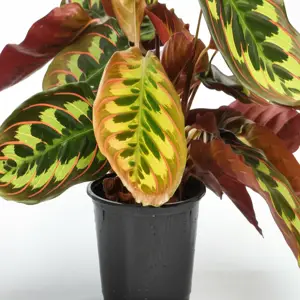
brown leaf edges
- Using Tap Water Without Letting it Sit: As mentioned earlier, tap water can contain harmful chemicals that can damage Calatheas.
- Overwatering: Overwatering is a common mistake that can lead to root rot.
- Exposing to Direct Sunlight: Direct sunlight can scorch the leaves of Calatheas.
- Ignoring Humidity Needs: Calatheas require high humidity to thrive.
- Neglecting Pest Control: Regular inspection and prompt treatment are essential for preventing pest infestations.
- Using the Wrong Potting Mix: Using a potting mix that doesn’t drain well can lead to overwatering and root rot.
Resources and Further Reading
For more information on Calathea care, here are some helpful resources:
- The American Horticultural Society: https://www.ahsgardening.org/
- The Royal Horticultural Society (RHS): https://www.rhs.org.uk/
- University Extension Services: Many universities offer extension services with valuable information on plant care. Search for your local university extension service online.
- Online Plant Forums and Communities: Online plant forums and communities can provide a wealth of information and support from experienced plant owners. *Consider linking to relevant plant forums here*
Where to Buy Healthy Calatheas
When purchasing a Calathea, it’s important to choose a healthy plant from a reputable source. Here are some options:
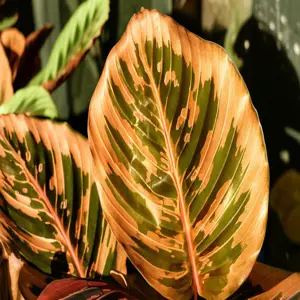
prayer plant problems
- Local Nurseries: Local nurseries often offer a wider selection of plants and more personalized advice than big-box stores.
- Online Plant Retailers: Many online retailers specialize in houseplants and offer a convenient way to purchase Calatheas. Be sure to read reviews and choose a reputable seller.
- Farmers Markets: Some farmers markets may feature local plant vendors selling healthy Calatheas.
When selecting a Calathea, look for plants with healthy, vibrant foliage and no signs of pests or diseases. Avoid plants with excessive browning or yellowing leaves.
FAQ: Frequently Asked Questions About Calathea Leaf Browning
Here are some frequently asked questions about Calathea leaf browning:
Why are the tips of my Calathea leaves turning brown?
Brown leaf tips are most commonly caused by low humidity, poor water quality (tap water with chlorine and fluoride), or underwatering. Increase humidity, use filtered water, and ensure consistent soil moisture.
Why are the edges of my Calathea leaves turning brown?
Similar to brown tips, brown edges are often a sign of low humidity, inconsistent watering, or exposure to drafts. Improve humidity, water consistently, and keep the plant away from drafts.
Can I cut off the brown parts of Calathea leaves?
Yes, you can trim off the brown parts of the leaves using clean, sharp scissors or pruning shears. This will improve the plant’s appearance, but it’s important to address the underlying cause of the browning to prevent it from recurring. Cut along the natural shape of the leaf, leaving a small margin of brown tissue to avoid further damage.
How often should I water my Calathea?
Water your Calathea when the top inch of soil feels dry to the touch. This typically translates to about once a week, but it can vary depending on the environmental conditions and the size of the pot. Always check the soil moisture before watering.
What type of water is best for Calatheas?
Filtered, distilled, or rainwater is best for Calatheas. Avoid using tap water, as it often contains chemicals that can damage the plant.
How can I increase humidity for my Calathea?
Use a humidifier, pebble tray, group plants together, or mist the leaves regularly to increase humidity around your Calathea.
Is direct sunlight bad for Calatheas?
Yes, direct sunlight can scorch the leaves of Calatheas. Place your Calathea in a location that receives bright, indirect light.
What are common pests that affect Calatheas?
Common pests that affect Calatheas include spider mites, mealybugs, and aphids. Inspect your plant regularly for signs of pests and treat promptly with insecticidal soap or neem oil.
When should I repot my Calathea?
Repot your Calathea when it becomes root bound, typically every 1-2 years. The best time to repot is during the spring or summer.
Why are my Calathea leaves curling?
Curling leaves often indicate low humidity or underwatering. Increase humidity and ensure consistent soil moisture.
Is brown tap water bad for calathea plants?
Yes, brown tap water can be detrimental to Calathea plants. The discoloration often indicates high levels of sediment, rust, or other contaminants, which can damage the plant’s roots and disrupt its ability to absorb nutrients.
These contaminants can also accumulate in the soil, leading to toxicity and ultimately causing the leaves to turn brown. Always use filtered, distilled, or rainwater for your Calathea to ensure its health and longevity.
Final Thoughts
While seeing your Calathea’s leaves turn brown can be frustrating, understanding the underlying causes and implementing the right solutions can bring your plant back to life. Remember, patience is key! It may take some time for your Calathea to recover, but with consistent care and attention, you can create the optimal environment for it to thrive. The tips and tricks covered in this guide can set you up for success, ensuring your Calathea remains a stunning centerpiece in your indoor garden for years to come.
Houseplant care is an ongoing learning process, and every plant is unique. Pay close attention to your Calathea’s specific needs and adjust your care routine accordingly. Don’t be afraid to experiment and try different techniques until you find what works best for your plant and your home environment. By providing the right light, humidity, water, and nutrients, you can help your Calathea reach its full potential and enjoy its vibrant beauty. Remember, a healthy Calathea not only enhances your living space but also contributes to a healthier and more vibrant indoor environment. So go ahead, give your Calathea some extra love and attention, and watch it flourish!
Auto Amazon Links: No products found.
Wilt-Pruf® Christmas Tree/Cutting Preserver Spray |Preserves Christmas Trees, Wreaths, Garlands, Cuttings and Carved Pumpkins | Reduces Needle Drop | Keeps Cut Trees Fresh Longer | Natural (32 oz)
$21.99 (as of November 16, 2025 21:47 GMT +00:00 - More info- Product prices and availability are accurate as of the date/time indicated and are subject to change. Any price and availability information displayed on [relevant Amazon Site(s), as applicable] at the time of purchase will apply to the purchase of this product.
Perfect Plants Christmas Tree Saver 8oz. | Easy Use Xmas Tree Preserver Food | Have Healthy Green Christmas Trees All Holiday Season
$13.99 (as of November 16, 2025 21:47 GMT +00:00 - More info- Product prices and availability are accurate as of the date/time indicated and are subject to change. Any price and availability information displayed on [relevant Amazon Site(s), as applicable] at the time of purchase will apply to the purchase of this product.
HoHoHoH2o Automatic Christmas Tree Watering System Device, Santa’s Tree Helper Keeps Your Christmas Tree Healthy and Fresh, Refillable 2.5 gallons Capacity Box - Silver/Festive
$99.95 (as of November 16, 2025 21:47 GMT +00:00 - More info- Product prices and availability are accurate as of the date/time indicated and are subject to change. Any price and availability information displayed on [relevant Amazon Site(s), as applicable] at the time of purchase will apply to the purchase of this product.
Christmas Tree Watering Funnel-Watertight Christmas Tree Funnel,Long Christmas Tree Watering System,Christmas Tree Waterer Xmas Plant Watering Tool for Real Live Tall Chirstmas Trees
$16.99 (as of November 16, 2025 21:47 GMT +00:00 - More info- Product prices and availability are accurate as of the date/time indicated and are subject to change. Any price and availability information displayed on [relevant Amazon Site(s), as applicable] at the time of purchase will apply to the purchase of this product.
Automatic Christmas Tree Watering System | Reduce Needle Loss | Never Have a Dry Stand | Evergreen Helper® | US Patent 12,102,249
$28.49 (as of November 16, 2025 21:47 GMT +00:00 - More info- Product prices and availability are accurate as of the date/time indicated and are subject to change. Any price and availability information displayed on [relevant Amazon Site(s), as applicable] at the time of purchase will apply to the purchase of this product.
Zevo Flying Insect Trap & 3 Refill Cartridges - Plug in Fly Trap & Indoor Bug Catcher for Gnats, House & Fruit Flies - Blue & UV Light Technology, Mess-Free Alternative to Bug Zapper
$25.96 (as of November 17, 2025 08:43 GMT +00:00 - More info- Product prices and availability are accurate as of the date/time indicated and are subject to change. Any price and availability information displayed on [relevant Amazon Site(s), as applicable] at the time of purchase will apply to the purchase of this product.
Zevo Flying Insect Trap Official Refill Cartridges - Fits Both Zevo Trap & MAX Indoor Fly Trap - Authentic Trap+Lock Technology to Catch Gnats, House & Fruit Flys (4 Official Refill Cartridges)
$14.97 (as of November 17, 2025 08:43 GMT +00:00 - More info- Product prices and availability are accurate as of the date/time indicated and are subject to change. Any price and availability information displayed on [relevant Amazon Site(s), as applicable] at the time of purchase will apply to the purchase of this product.
TERRO Fruit Fly Traps for Indoors (4 Pack) + 180 Days of Lure Supply
$10.95 (as of November 17, 2025 08:43 GMT +00:00 - More info- Product prices and availability are accurate as of the date/time indicated and are subject to change. Any price and availability information displayed on [relevant Amazon Site(s), as applicable] at the time of purchase will apply to the purchase of this product.
TERRO Ant Killer Bait Stations T300B - Liquid Bait to Eliminate Ants - Bait System - 12 Count Stations for Effective Indoor Ant Control
$11.44 (as of November 17, 2025 08:43 GMT +00:00 - More info- Product prices and availability are accurate as of the date/time indicated and are subject to change. Any price and availability information displayed on [relevant Amazon Site(s), as applicable] at the time of purchase will apply to the purchase of this product.
Advion Cockroach Gel Bait, 4 Tubes x 30-Grams, 1 Plunger and 2 Tips, German Roach Insect Pest Control, Indoor and Outdoor Use, Roach Killer Gel for American, German and Other Major Cockroach Species
$26.99 (as of November 17, 2025 08:43 GMT +00:00 - More info- Product prices and availability are accurate as of the date/time indicated and are subject to change. Any price and availability information displayed on [relevant Amazon Site(s), as applicable] at the time of purchase will apply to the purchase of this product.

